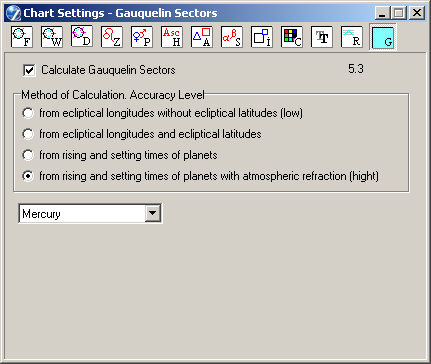Chart Settings - Gauquelin Sectors
The Chart Settings window consists of several thematic tabs of options for calculating and displaying horoscope charts. The Gauquelin Sectors tab calculates and displays the sector numbers for individual planets.
The Chart Settings - Gauquelin Sectors tab is opened by first:
- selecting "Settings" | "Chart Settings" from the main menu, or
- clicking the
 "Options" Toolbar button
and selecting "Chart Settings..." from the menu, or
"Options" Toolbar button
and selecting "Chart Settings..." from the menu, or
- right-clicking in the Chart tableau and selecting "Chart Settings..." from the popup menu, or
- double-clicking in an empty region of the Chart tableau.
Then by clicking the "Gauquelin Sectors" button
at the top of the window, or typing the 'G' key.

This is the 'house' system used by the Gauquelins and their epigones and critics in statistical investigations of astrology. Basically, it is identical to the Placidus house system, i.e. subdivision of the diurnal and nocturnal arcs of ecliptic points or planets. There are a couple of differences, though.
- Up to 36 'sectors' (or house cusps) are used instead of 12 houses.
- The sectors are counted in a clockwise direction.
- There are so-called plus (+) and minus (–) zones. The plus zones are the sectors that turned out to be significant in statistical investigations, e.g. many top sportsmen turned out to have their Mars in a plus zone. The plus sectors are the sectors 36 to 3, 9 to 12, 19 to 21, 28 to 30.
- More sophisticated algorithms are used to calculate the exact house position of a planet (see swisseph.doc chapters 6.4 and 6.5).
Several options are available for setting technical features of the Gauquelin sector calculation. After activating the Gauquelin Sectors checkbox, selecting a planet from the drop-down list box results in the display of the planet's sector at top right of the panel. In the example shown above, Mercury is located in the 5th sector.